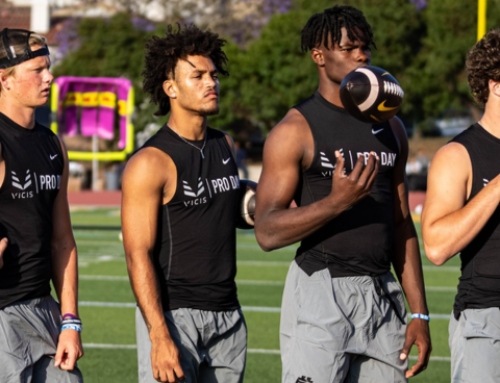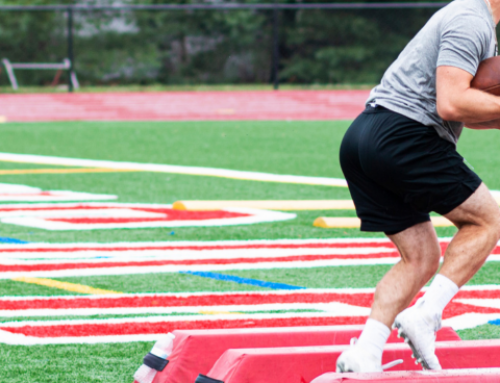Why Your Big Vertical Jump Isn’t Showing Up During Games
Being able to jump higher is an offseason goal for many athletes.
Who wouldn’t want to have the bounce to throw down a thunderous dunk or to score that crucial late-game header goal? Few things look more athletic than a 30-plus-inch vertical, while anything 40 and up is simply jaw-dropping.
In their quest for a higher jump, athletes will often focus on pumping up their Squat and Deadlift numbers. They may throw in a few Box Jumps or Power Cleans to develop more power. These are all a very good start in the process of jumping higher. Following these simple methods will help an athlete achieve a higher vertical jump over time, and if they’re gifted, they just may be able to come in and record a vertical jump over 30 inches.
Awesome, right? Just one problem—when the time comes to actually play their sport, their new-found springs aren’t showing up.
The issue here is that the way athletes jump in games is often quite different from how they jump during a vertical jump test. Watch athletes as they test their vertical jump. You’ll often see athletes drop very deep into a squat during their jump. A 2018 article published in the journal Sports found that deeper countermovement jumps lead to improved jump height. This jumping technique may allow an athlete to jump high for a test, but it’s rarely practical for in-game performance.
In Special Strength Training Yuri Verkhoshansky defines seven different strength abilities. The qualities that are most developed when an athlete focuses on building their Squat and Box Jumps are maximal strength, high-speed strength, explosive strength and starting strength. The problem with this list is that it is missing reactive ability, which is defined by Verkhoshansky as “the specific quality of the nervous-muscular system to display a powerful explosive effort immediately after sharp mechanical stretching of the muscles by an external force.”
Reactive ability is displayed when you watch top-10 plays and see a basketball player put someone on a poster, or a football player pull off a miraculous hurdle over a defender. You’ll never see those athletes hit a deep squat before jumping. They likely only have a slight knee bend, at most.
Now think about how you hit that big vertical. Did you get down real deep before jumping? Or did you only bend a little? If you’re not sure, record yourself performing a vertical jump.
If you are dropping deep into a squat, that’s a great way to record an impressive vertical jump number, but that won’t work during a game.
To help a big vertical translate to games, improving the specificity of your training by focusing more on reactive ability will be your best bet. More of your jumps in training need to look like what you are trying to do in games. That means popping off the ground quickly and doing it from a moving start rather than always preceding jumps with a deep squat and performing them from a standstill.
You may not have to change the exact exercises that you are doing, but re-think the way that they are performed. What would make them more like how you need to jump during games?
Can you add a run-up to your box jumps? Can you focus more on getting off the ground quickly? Can you practice making your vertical and broad jumps continuous and reduce your ground contact time? Can you dynamically react to a ball being thrown and jump to go get it? Additionally, athletes tend to jump off one foot during games, not two. Can you integrate more Skips for height?
The other thing to remember is to train the actual jumping skills you need for your sport! If you’re a basketball player trying to dunk, spend time working on dunking or attempting to dunk. If you’re a soccer player trying to win more headers, practice being served or thrown high balls and going up to get them. If you’re a football receiver who wants to win more jump balls, grab a couple teammates and practice jumping for those 50/50 balls!
That movement needs to be drilled to properly get the technique and jumping ability that you want.
A vertical jump is great, but too often, it doesn’t carry over into games. Use these tips and watch your hops show up when it matters most.
Photo Credit: bernardbodo/iStock
READ MORE:
RECOMMENDED FOR YOU
MOST POPULAR
Why Your Big Vertical Jump Isn’t Showing Up During Games
Being able to jump higher is an offseason goal for many athletes.
Who wouldn’t want to have the bounce to throw down a thunderous dunk or to score that crucial late-game header goal? Few things look more athletic than a 30-plus-inch vertical, while anything 40 and up is simply jaw-dropping.
In their quest for a higher jump, athletes will often focus on pumping up their Squat and Deadlift numbers. They may throw in a few Box Jumps or Power Cleans to develop more power. These are all a very good start in the process of jumping higher. Following these simple methods will help an athlete achieve a higher vertical jump over time, and if they’re gifted, they just may be able to come in and record a vertical jump over 30 inches.
Awesome, right? Just one problem—when the time comes to actually play their sport, their new-found springs aren’t showing up.
The issue here is that the way athletes jump in games is often quite different from how they jump during a vertical jump test. Watch athletes as they test their vertical jump. You’ll often see athletes drop very deep into a squat during their jump. A 2018 article published in the journal Sports found that deeper countermovement jumps lead to improved jump height. This jumping technique may allow an athlete to jump high for a test, but it’s rarely practical for in-game performance.
In Special Strength Training Yuri Verkhoshansky defines seven different strength abilities. The qualities that are most developed when an athlete focuses on building their Squat and Box Jumps are maximal strength, high-speed strength, explosive strength and starting strength. The problem with this list is that it is missing reactive ability, which is defined by Verkhoshansky as “the specific quality of the nervous-muscular system to display a powerful explosive effort immediately after sharp mechanical stretching of the muscles by an external force.”
Reactive ability is displayed when you watch top-10 plays and see a basketball player put someone on a poster, or a football player pull off a miraculous hurdle over a defender. You’ll never see those athletes hit a deep squat before jumping. They likely only have a slight knee bend, at most.
Now think about how you hit that big vertical. Did you get down real deep before jumping? Or did you only bend a little? If you’re not sure, record yourself performing a vertical jump.
If you are dropping deep into a squat, that’s a great way to record an impressive vertical jump number, but that won’t work during a game.
To help a big vertical translate to games, improving the specificity of your training by focusing more on reactive ability will be your best bet. More of your jumps in training need to look like what you are trying to do in games. That means popping off the ground quickly and doing it from a moving start rather than always preceding jumps with a deep squat and performing them from a standstill.
You may not have to change the exact exercises that you are doing, but re-think the way that they are performed. What would make them more like how you need to jump during games?
Can you add a run-up to your box jumps? Can you focus more on getting off the ground quickly? Can you practice making your vertical and broad jumps continuous and reduce your ground contact time? Can you dynamically react to a ball being thrown and jump to go get it? Additionally, athletes tend to jump off one foot during games, not two. Can you integrate more Skips for height?
The other thing to remember is to train the actual jumping skills you need for your sport! If you’re a basketball player trying to dunk, spend time working on dunking or attempting to dunk. If you’re a soccer player trying to win more headers, practice being served or thrown high balls and going up to get them. If you’re a football receiver who wants to win more jump balls, grab a couple teammates and practice jumping for those 50/50 balls!
That movement needs to be drilled to properly get the technique and jumping ability that you want.
A vertical jump is great, but too often, it doesn’t carry over into games. Use these tips and watch your hops show up when it matters most.
Photo Credit: bernardbodo/iStock
READ MORE:










